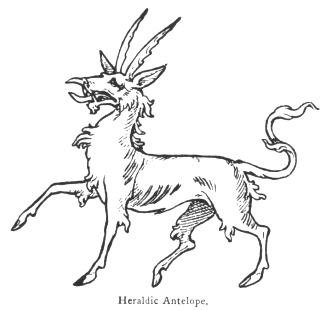
Masonic, Occult and Esoteric Online Library
Fictitious and Symbolic Creatures in Art
By John Vinycomb
Other Chimerical Creatures and Heraldic Beasts- Heraldic Antelope
This fictitious animal, when depicted in heraldry, has a body like that of a stag, the tail of a unicorn, a head like the heraldic tiger, with two serrated horns, and a tusk growing from the tip of his nose, a row of tufts down the back of his neck, and the like on his tail, chest and thighs. Thus represented it is termed an heraldic antelope to distinguish it from the real or natural antelope, which is also borne in modern coats of arms.
The old heralds, with their scant knowledge of the rarer kinds of foreign animals, represented the antelope as a fierce beast of prey, and totally unlike in appearance and in disposition to the beautiful small-limbed gentle creature with which we are acquainted. That such was the prevailing opinion
in the time of Spenser is evident. In the "Faerie Queen" he makes the stout Sir Satyrane—
Amongst wild beasts and woods from laws of man exiled."
—more than a match for the most ferocious brutes, all of whom he subdues:
The spotted panther, and the tuskéd boar;
The pardale swift, and the tiger cruel,
The antelope and wolf, both fierce and fell;
And them constrain in equal team to draw."
Some authorities give the heraldic antelope with two straight horns, but as the ancient badge of the House of Lancaster it was represented with two serrated horns curving backward.
In blazon, the term "heraldic antelope" should always be used unless the natural antelope is intended.
